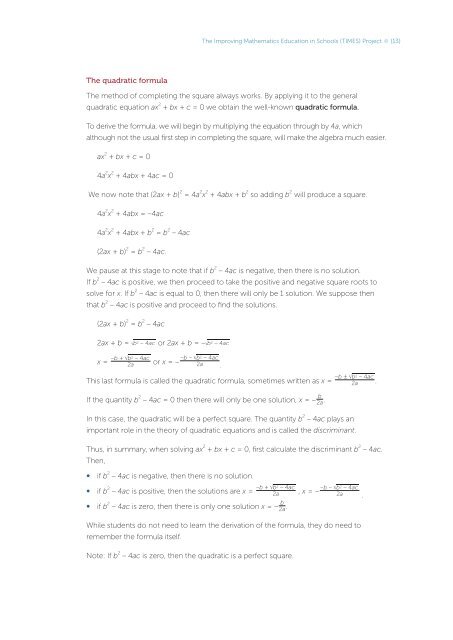quadratic equations - the Australian Mathematical Sciences Institute
quadratic equations - the Australian Mathematical Sciences Institute
quadratic equations - the Australian Mathematical Sciences Institute
- No tags were found...
Create successful ePaper yourself
Turn your PDF publications into a flip-book with our unique Google optimized e-Paper software.
The Improving Ma<strong>the</strong>matics Education in Schools (TIMES) Project{13}The <strong>quadratic</strong> formulaThe method of completing <strong>the</strong> square always works. By applying it to <strong>the</strong> general<strong>quadratic</strong> equation ax 2 + bx + c = 0 we obtain <strong>the</strong> well-known <strong>quadratic</strong> formula.To derive <strong>the</strong> formula, we will begin by multiplying <strong>the</strong> equation through by 4a, whichalthough not <strong>the</strong> usual first step in completing <strong>the</strong> square, will make <strong>the</strong> algebra much easier.ax 2 + bx + c = 04a 2 x 2 + 4abx + 4ac = 0We now note that (2ax + b) 2 = 4a 2 x 2 + 4abx + b 2 so adding b 2 will produce a square.4a 2 x 2 + 4abx = –4ac4a 2 x 2 + 4abx + b 2 = b 2 – 4ac(2ax + b) 2 = b 2 – 4ac.We pause at this stage to note that if b 2 – 4ac is negative, <strong>the</strong>n <strong>the</strong>re is no solution.If b 2 – 4ac is positive, we <strong>the</strong>n proceed to take <strong>the</strong> positive and negative square roots tosolve for x. If b 2 – 4ac is equal to 0, <strong>the</strong>n <strong>the</strong>re will only be 1 solution. We suppose <strong>the</strong>nthat b 2 – 4ac is positive and proceed to find <strong>the</strong> solutions.(2ax + b) 2 = b 2 – 4ac2ax + b = b 2 – 4ac or 2ax + b = – b 2 – 4acx = –b + b2 – 4ac2a or x = – –b – b2 – 4ac2a .This last formula is called <strong>the</strong> <strong>quadratic</strong> formula, sometimes written as x = –b ± b 2 – 4ac2a .If <strong>the</strong> quantity b 2 – 4ac = 0 <strong>the</strong>n <strong>the</strong>re will only be one solution, x = – b 2a .In this case, <strong>the</strong> <strong>quadratic</strong> will be a perfect square. The quantity b 2 – 4ac plays animportant role in <strong>the</strong> <strong>the</strong>ory of <strong>quadratic</strong> <strong>equations</strong> and is called <strong>the</strong> discriminant.Thus, in summary, when solving ax 2 + bx + c = 0, first calculate <strong>the</strong> discriminant b 2 – 4ac.Then,• if b 2 – 4ac is negative, <strong>the</strong>n <strong>the</strong>re is no solution.• if b 2 – 4ac is positive, <strong>the</strong>n <strong>the</strong> solutions are x = –b + b2 – 4ac2a• if b 2 – 4ac is zero, <strong>the</strong>n <strong>the</strong>re is only one solution x = – b 2a ., x = – –b – b2 – 4ac2a .While students do not need to learn <strong>the</strong> derivation of <strong>the</strong> formula, <strong>the</strong>y do need toremember <strong>the</strong> formula itself.Note: If b 2 – 4ac is zero, <strong>the</strong>n <strong>the</strong> <strong>quadratic</strong> is a perfect square.
















